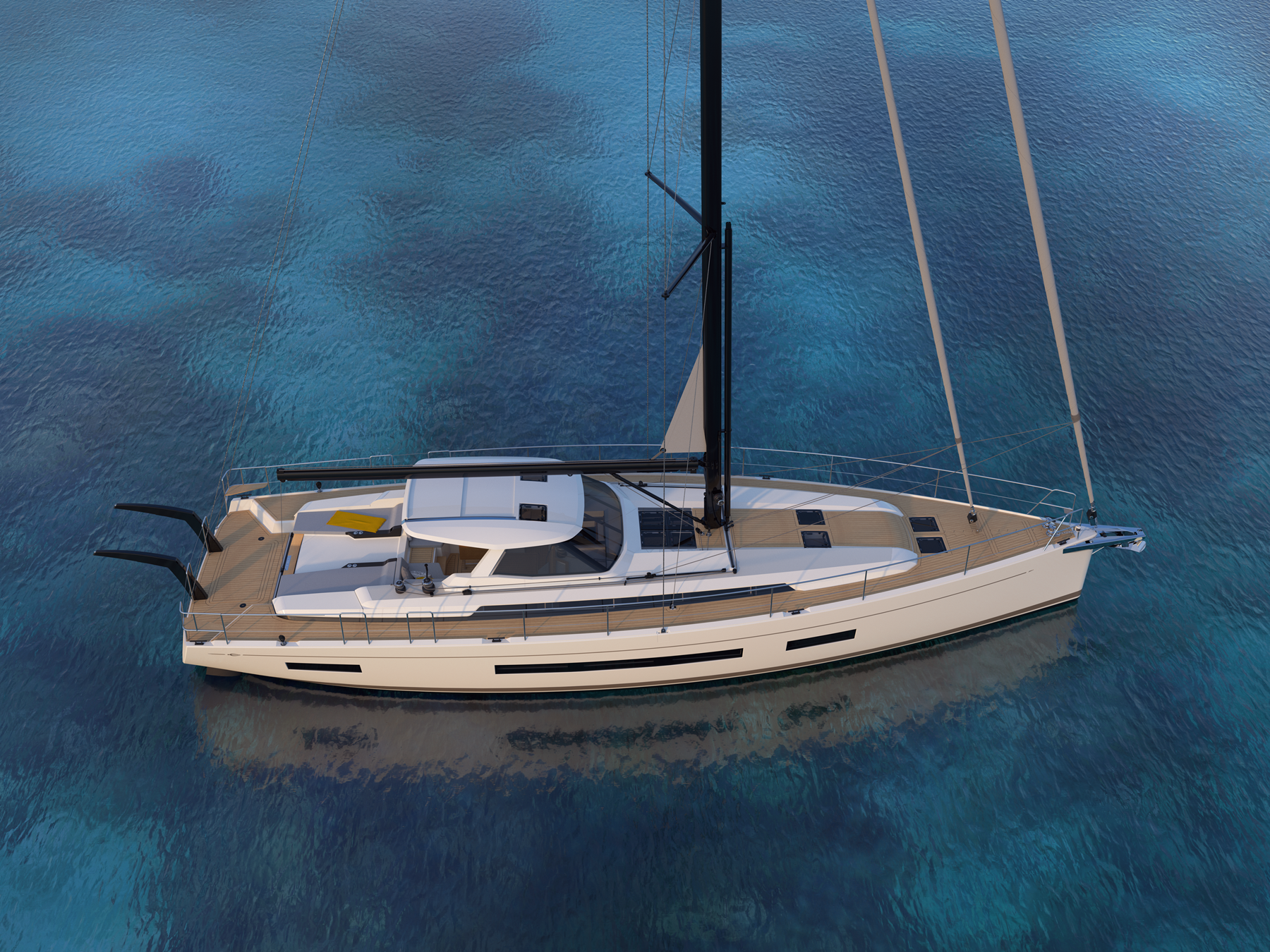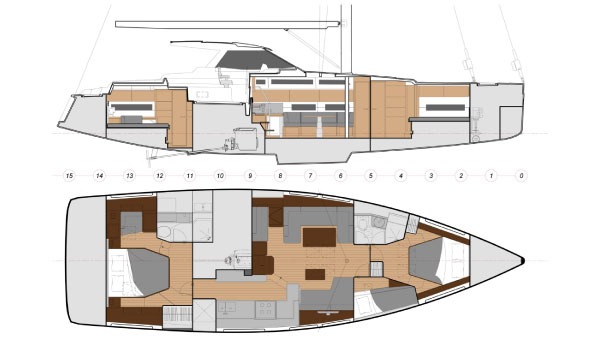Hull and rigging main specifications
The design of this new blue water cruiser is truly modern. From a general point of view, the boat is more compact and has straighter and more extended lines. The main beam of this new hull is really large and positioned forward. It extends its width on the whole aft of the boat until the stern. This design grants the hull with many advantages, such as particularly increased sailing performance and huge interior volumes.
Deck line

The deck line is slightly domed at the level of the main beam and has a visual effect which refines the superstructures. The front, slightly lowering part of the line increases the dynamism of the bow design. Thanks to this inverted deck line, a comfortable height can be maintained in the cockpit, in the engine room and inside the boat, such as in the galley.
Bow design

The vertical bow emphasizes the modernity of the boat’s figure, which line is extended by the beautiful stainless steel bow sprit. This new design increases the hull length at the waterline, which gives greater speed to the hull and more efficiency sailing on the wind. Moreover, with a wide and flat stern a long and deep bow shape will bring additional control capacity on the hull. This volume on the front part of the boat is also very interesting when getting to reach points, for it allows more comfortable speeding-up and avoids nose diving.
The bowsprit has a functional interest because it allows to keep the anchor away and to protect the vertical bow. It also supports the tack point dedicated to generous front sails such as a spinnaker, a gennaker, and other downwind sails, by keeping them distant from the genoa.
Cockpit

An important point of the AMEL 50 specifications is the cockpit volume. The main living space of the boat is extremely generous on this model. It remains of course central and ultra-protected, as always on an AMEL. Sailing in a deep and central cockpit has the advantage to weaken the feeling of the boat’s movements, and it also keeps the crew in a secure and safe space.
This new cockpit is very roomy and is widely opened to the aft sunbathing area, giving an extremely comfortable deck-living space. The traditional hardtop has been lengthened and protects the whole cockpit area. The aft part of the dodger can slide in and open to the sun and to the air. Like on the other models of the range, the ventilation of the cockpit is made through the opening central windshield panel, and by two opening hatches in the hardtop.
The view from each point is 360° clear and allows a permanent visibility from any position during a watch. In addition, the watcher and any other crew staying in the cockpit can keep an eye on the navigation data displayed on the instruments now positioned above the companion way.
Sloop rig

This is of course an important point on this new sailing boat: The sloop rig is back at AMEL.
We already built this type of rig in the past, and it appears to be mostly adapted to the dimensions of the AMEL 50. Above all, our wish for this new model is to keep on offering easy handling for a reduced crew.
Standing rigging
The mast is 20.5m high, which is 1.6m higher than the AMEL 55 main mast. The boom is also longer, which allows the mainsail to have a very respectable surface of 62m². For information, the AMEL 64 mainsail area is 58m². Of course our traditional electric mast furling system is here to help the navigator easily handle this sail area.
Sails

As a consequence of the mast height induced by the sloop rig, and its position retracted from the bow compared to an AMEL 55 or 64, the genoa is proportionally more streamlined upward than on the other range models. However, it has a smaller covering on the mainsail. Its total area is 65m². This sail profile with a higher luff and a shorter foot is cut for efficient upwind performance. The rule is that the higher and thinner a sail is, the better the performance is, for it produces less drag. This asset should be very appreciated when frequently sailing close hauled, such as during coastal navigation in the Mediterranean for instance.
For reach points of sail, the hull shape – flat aft and voluminous bow — combined with twin rudders and a forward sail such as a gennaker promises beautiful sailing sensations.
Self-tacking staysail

The sloop rig allows us to use a very interesting innovation, completely adapted to the AMEL concept of easy handling for reduced crew: the self-tacking staysail. As the mast is positioned further back on the deck, it leaves enough room for the long cross sheet traveler dedicated to this device. The staysail will require only one sheet, which will return in the cockpit next to the mainsail sheet. Thanks to this sail, combined with the autopilot, tacking in strong winds with a reduced crew will be a child’s play. The staysail is available on manual or electric furler.





